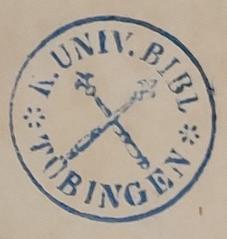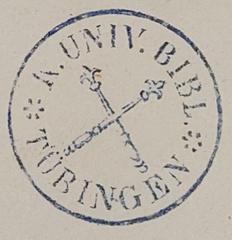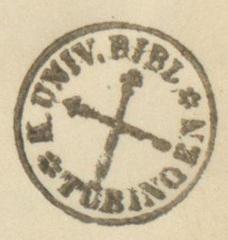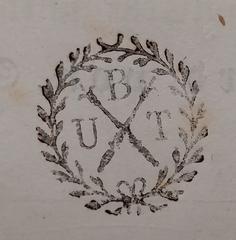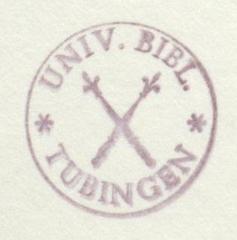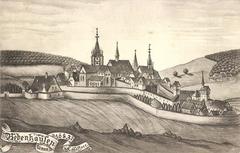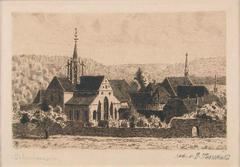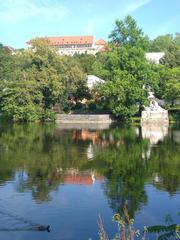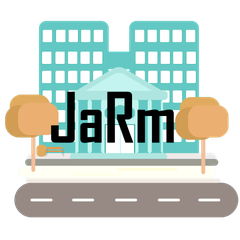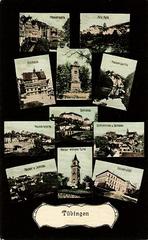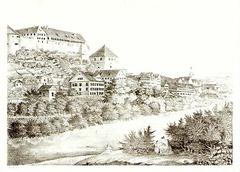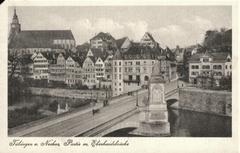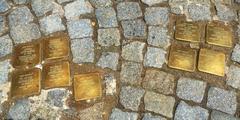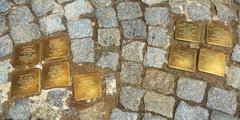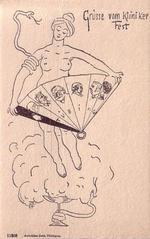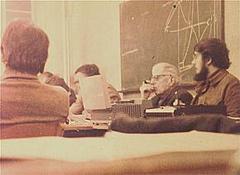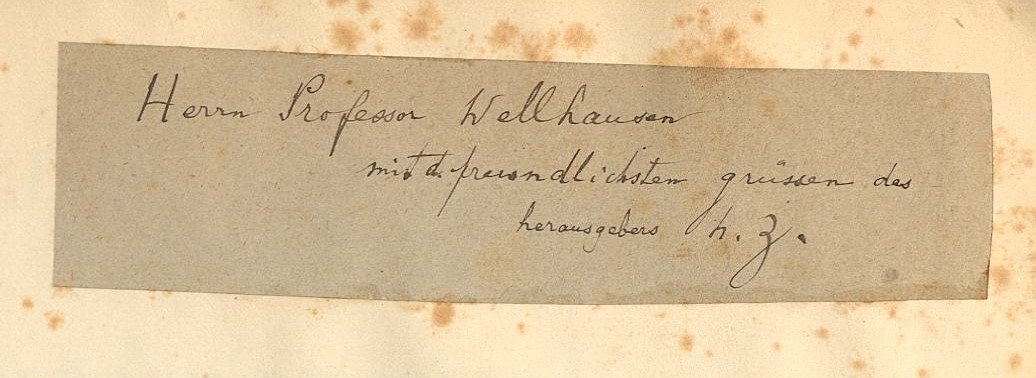
University Library of Tübingen: Visiting Hours, Tickets, and Historical Sites Guide
Date: 14/06/2025
Introduction
The University Library of Tübingen (Universitätsbibliothek Tübingen), established in 1477 alongside the Eberhard Karls Universität Tübingen, is a cornerstone of academic excellence and a celebrated historical landmark. Located in the heart of Tübingen, Germany, this library stands out not only for its scholarly resources but also for its architectural significance and role in European intellectual history.
Whether you are a student, researcher, history enthusiast, or a traveler exploring Tübingen’s historical sites, the University Library offers an immersive experience. Visitors can explore rare manuscripts, enjoy modern amenities, and appreciate architectural highlights that span from neoclassical grandeur to modernist innovation. This guide will provide comprehensive information on visiting hours, tickets, guided tours, facilities, accessibility, and nearby attractions to help you plan a rewarding visit.
For updated details on hours, events, and exhibitions, please consult the official University Library of Tübingen website.
Contents
- Introduction & Why Visit
- Historical Foundations & Architectural Milestones
- Visiting Hours, Tickets, and Guided Tours
- Facilities and Visitor Services
- Special Collections and Cultural Significance
- Accessibility and Practical Tips
- Nearby Attractions
- Frequently Asked Questions (FAQ)
- Sources and Further Reading
Why Visit the University Library of Tübingen?
The University Library of Tübingen is much more than an academic resource—it’s a living testament to over five centuries of intellectual heritage. With vast collections, including medieval manuscripts and rare incunabula, and a blend of historic and contemporary architecture, the library is a must-see destination for anyone interested in history, culture, or scholarship.
Historical Foundations and Architectural Evolution
Origins and Growth:
Founded in 1477, the library’s early collections were mainly in theology, philosophy, and law. The Reformation and the secularization of monasteries in the 16th century brought in valuable manuscripts and early printed works, establishing the library as a leading academic repository.
Architectural Milestones:
- Early Locations: Initially housed in various university buildings, the library received a dedicated neoclassical building in 1912, designed by Paul Bonatz.
- Modernist Expansion: The main building, constructed in the 1970s, features modernist design elements, including open-plan reading areas and extensive use of glass and concrete.
- 21st Century Renovations: Recent renovations focus on digital integration, expanded study spaces, and full accessibility, blending historic features with modern amenities.
Visiting Information: Hours, Tickets, and Guided Tours
Visiting Hours
- Monday–Friday: 8:00 AM – 10:00 PM
- Saturday: 9:00 AM – 8:00 PM
- Sunday: 10:00 AM – 8:00 PM
Hours may vary during holidays, exam periods, or special events. Always check the official library website for current opening times.
Admission and Tickets
- Free Entry: No ticket is required for entry; the library is open to the public.
- Registration: External visitors may need to register at the information desk for access to special collections or borrowing privileges. A valid ID or passport is required.
Guided Tours
- Availability: Regular guided tours highlight the library’s history, architecture, and special collections.
- Languages: Tours are generally in German, with English tours available by prior arrangement.
- Booking: Book tours through the library’s visitor information page.
Facilities and Visitor Services
Reading and Study Spaces
- Over 1,200 individual and group study spaces, including silent reading rooms and group work areas.
- Lockers and cloakrooms are provided for secure storage.
- Free Wi-Fi access and abundant power outlets.
Special Collections and Exhibitions
- Houses over 3.4 million volumes, including rare manuscripts, incunabula, and early printed books.
- Temporary exhibitions often showcase highlights from the collections and are open to the public.
Multimedia and Technology
- Public computer terminals for catalog and internet access.
- Printing and photocopying services (with prepaid cards).
- Media labs with audio-visual editing and 3D printing capabilities.
Accessibility
- Wheelchair-friendly entrances, elevators, and accessible restrooms.
- Staff are trained to assist visitors with special needs; guide dogs are permitted.
Café and Refreshments
- While there is no in-house café, nearby university cafeterias and local bakeries within walking distance offer refreshments.
- Vending machines for drinks and snacks are available in the lobby.
Special Collections and Cultural Significance
The library is renowned for its rare and historical collections:
- Rare Manuscripts: Nearly 900 Indian and 900 Near Eastern manuscripts, alongside 350 medieval and 3,000 early modern European manuscripts.
- Incunabula: Around 2,200 books printed before 1501.
- Rara Collection: About 90,000 rare volumes, including books printed before 1700.
- Unique Artifacts: Including a cannonball from the 17th-century siege of Hohentübingen Castle.
Many items are digitized for global access. The library regularly hosts exhibitions and public events that celebrate its intellectual heritage and contributions to European culture.
Accessibility and Practical Tips
- Language Support: Signage is bilingual (German/English). Staff speak English and guides are available in multiple languages.
- Quiet Zones: Respect designated quiet areas. Store large bags in lockers; water bottles are allowed in most areas.
- Photography: Permitted in public areas for personal use (no flash or tripods). Professional photography requires prior permission.
- Visitor Registration: Required for borrowing privileges or accessing certain collections.
Nearby Attractions
The library’s central location makes it ideal for exploring Tübingen’s historical sites, including:
- Hohentübingen Castle: Home to the Museum of Ancient Cultures and panoramic city views (Simplify Live Love).
- Neckarinsel (Neckar Island): A scenic park along the river.
- Altstadt (Old Town): Famed for medieval architecture and vibrant marketplace (Visit Tübingen).
Frequently Asked Questions (FAQ)
Q: What are the University Library of Tübingen visiting hours?
A: Monday–Friday: 8:00 AM–10:00 PM; Saturday: 9:00 AM–8:00 PM; Sunday: 10:00 AM–8:00 PM. Check the official website for updates.
Q: Do I need tickets to enter?
A: No, entry is free. Registration may be needed for borrowing or special collections.
Q: Are guided tours available?
A: Yes, tours can be booked in advance, with English tours offered upon request.
Q: Is the library accessible for visitors with disabilities?
A: Yes, it’s fully accessible.
Q: Can I take photographs inside?
A: Yes, in public areas for personal use.
Conclusion
The University Library of Tübingen stands as a testament to centuries of academic achievement and architectural innovation. It is an essential stop for anyone visiting Tübingen—offering unparalleled access to rare collections, modern facilities, and a welcoming environment for all.
For the latest information on visiting hours, tickets, and guided tours, visit the official library website. Enhance your experience with the Audiala app for guided audio tours, and stay updated via the library’s social media channels.
Sources and Further Reading
- University Library of Tübingen Official Website
- University Library Facilities and Visitor Information
- University Library Visitor Guide
- University of Tübingen – International Study Information
- 15 Best Things to Do in Tübingen, Germany
- History of Tübingen
- Tübingen Travel Guide

